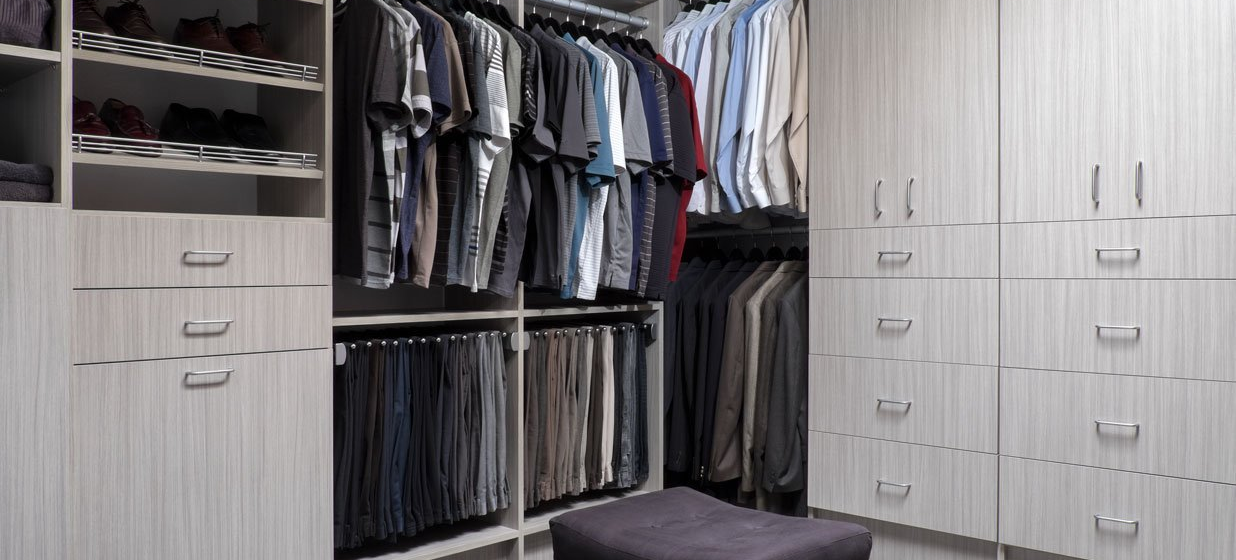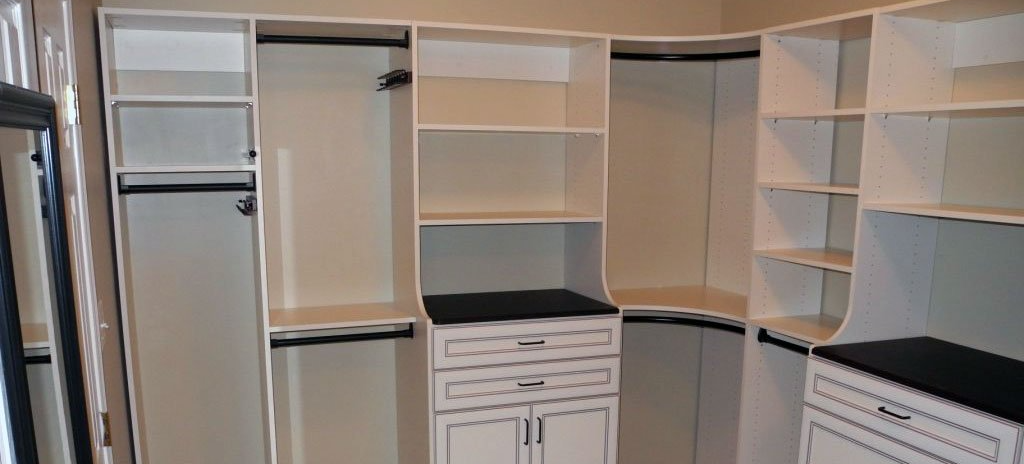CALL US: (732) 391-4411
How To Design Closet Corners – Straight vs. Curved
The question that always pops up on a custom closet system consultation is what about the corners? With a simple builder grade wire ventilated shelving or pole and shelf closet the corners are connected at 90 degrees. One length of wire or wood runs directly into a wall. The other length of wire or wood runs directly into the other wire or wooden shelf at a 90 degree angle. This forces the homeowner to make an unconscious decision. Regardless of which wall they run the clothes into they have to stop the other way at least 24” off the wall to gain access to the existing clothes. It might be hard to visualize so take a look at your current closet configuration.
Options in Corners
The current option provided by most closet companies is to simply run the clothes into one wall and start the perpendicular closet system anywhere from 24” to 30” from the opposite wall. This is a much better option over the connected wire as it allows the homeowner to have total access to the clothes that run up against the wall. During my complimentary appointment I am always asked what about the wasted space that is left, the conscious void I created by leaving the 24” – 30” of space, between the wall and the next section. Fortunately, with my 3D software I can populate the area with clothes allowing the customer to see that the void is filled with the appropriate amount of space left open to see the clothes against the wall.
The other option is to curve the corner with a curved pole and a curved shelf to match. This allows the opposing walls to have a connected look at the corners instead of the start and stop look provided with traditional corners. Most closet companies don’t have the ability to curve the corners with a shelf that matches that same curve. Without the curved option closet designers push the start/stop look and falsely create a variety of reasons why curves don’t work.
Does it waste or gain space?
The Math Behind the Curve
You might say that mathematically it appears you are wasting space but this gets disproven when we do the hanger test. For those of you who want a complete explanation of the math calculations please scroll down to the summary below. For those of you who hate math please read on.
The Hanger and Clothes Test
I placed as many empty plastic hangers I could fit on a straight 30” pole and came up with 89. I took the same number of hangers and placed them on a curved pole and hung 83 or a total loss of 6%. Not a large loss by any stretch. Next I crammed as many clothes as I could on the straight bar and was able to place the same number on the curved bar. There was no way to determine what an appropriate cram factor is on the curved vs. straight pole. I will agree there is more of a “bunching” factor on the curved pole vs. the straight pole. Based on the hanger/clothes test the curved pole does not waste much space.
Aesthetics
Let’s face it you are not organizing your closet for 100% function. There is a balance of function and aesthetics. If it were only function we would not have doors, slanted shoe shelves, various color options, crown/base molding at our disposal. Closets would be designed in white, maximizing every inch of space with no flare. After installing thousands of closets, the curved monolithic connected corner looks absolutely amazing. As a consumer wouldn’t you rather have the option to see a 3D design of curved corners in your closet and make the decision based on unbiased information rather than simply have a designer tell you it is not a good idea because they cannot provide the solution?
Can My Closet Have Curved Poles and Shelves?
The larger the closet the easier it is to utilize curved corners, only a closet consultation can verify. However, narrow “L” shaped closets are a good fit for the curve.
Not all closets are a good fit for curved corners. Curved corners cannot be installed in reach in closets and in closets that have walls containing corners that are angled other than 90 degrees.
Curved corners are fixed in size and are built around the corners making everything custom fit in between. During the consultation I present all of the pros and cons to the customer and show their closet designed both ways. An informed customer with all the options allows them to make a decision based on their needs letting them weigh investment vs. form vs. function.
Closet Math 101
To make sure available space is the same we will assume two partitions set apart 30” using a curved pole vs. a straight pole. You are thinking, how can they be the same spacing if one is curved? The straight pole has two partitions 30” from one another. That is simple! Now vision the curved pole has one partition 30” from the corner and the other partition is also 30” from the corner. Both partitions are parallel with the walls they are measured from but perpendicular to one another. See below:
The straight pole is pretty “straight” forward; a 30” pole gives us about 29-1/2” of linear hanging space once we deduct the pole cups on each side. The curved pole has a radius of 19” to make the curve connected to the standard holes on a 14” partition. (This radius was measured directly from a curved pole) It is really a 1/4 of a full circle with a diameter of 38”.
Circumference of a circle is = Pie X Diameter with the modified equation as follows:
29.85” = 1/4 * 3.1415 * 38”
Rounding off, the curved pole is the same length of the straight pole and the curved pole has flat flanges without pole cups allowing clothes to go full length.
Summary
Closet companies and designers who don’t have the ability to curve the corner will always make the curve a negative, stating it wastes space and the clothes bunch up in the front and fan out in the back. I will agree that there is a little bit of wasted space with the clothes going around a curve rather than straight as shown in the tests. However, the clothes lost in the curve are offset by visibility. When a straight pole goes into a corner there are clothes against the corner that are not readily visible as compared to the curved pole where everything is extremely visible. The argument stating curved corners waste space is similar to that of crown molding. However, the reason you will not have designers taut the wasted space inherent in crown molding installation, is simple, they have access to the crown, can install it, generate a profit and it looks great with no function! Crown molding makes the top shelf around the closet completely unusable to store clothes. The installation of crown molding wastes more folded space than any curved pole will waste in hanging space.
Once the project is complete, by far, the curved connected corners will out shine the start and stop corners hands down. Aesthetically they completely tie together the entire closet bringing the custom closet to the next level of elegance. Customers are ok with the little bit of lost hanging space in the curve as the benefits of the overall look and flow more than outweigh 6% of loss. Customers with multiple closets in the home (Master closets and children’s walk in closets) who have both the curved corners and straight start and stop corners always prefer the curved closet corners.
Call All About Closets now at 732-391-4411 to have an engineer come out and give you a complimentary in home design of your custom closet.
 George Chowanec
George Chowanec
Owner
George obtained a Master of Science Engineering Degree from New Jersey Institute of Technology. After graduation, he worked at AT&T Bell Labs and Lucent Technologies after the company split. With an extensive background in construction management and ergonomic space design, spanning residential and commercial, designing and installing closets in New Jersey is second nature for him.
Quick Links
Contact Info
All About Closets LLC
699 Challenger Way Unit D4
Forked River, NJ 08731
Phone: (732) 391-4411
Company Hours
Copyright © 2024 All About Closets LLC. All Rights Reserved. Website & Marketing By Local Visibility



